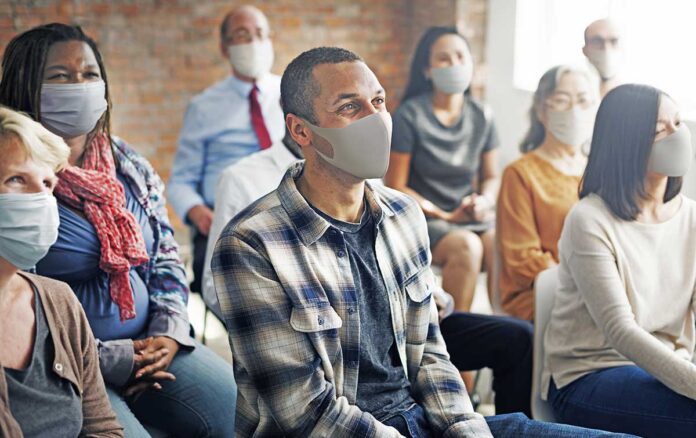Federal health officials urged Americans in areas of the country with the highest surges in COVID-19 infections to once again wear masks when they are in public, indoor settings — even if they are fully vaccinated against COVID-19.
The updated recommendations marked a sharp shift from the agency’s guidance in May that Americans fully vaccinated against COVID-19 do not need to wear a mask in most situations, indoors and outdoors.
The updates also included changes for schools, with federal health officials now urging everyone in K-12 schools to wear a mask indoors. That includes teachers, staff, students and visitors, regardless of vaccination status and the level of community transmission.
The update in CDC guidance was prompted by new data indicating that although breakthrough infections among the vaccinated are rare, those individuals still may be contagious and able to spread the disease to others, said Dr. Rochelle Walensky, director of the Centers for Disease Control and Prevention.
Wearing a mask indoors in areas with “substantial” or “high” transmission of the virus could help to reduce further outbreaks of the highly contagious delta variant, she said.
Some 39 states have infection rates that have reached “substantial” or “high” levels of transmission, according to a data tracker on the CDC website.
The agency also tracks infection rates on the county level, and 63 percent of U.S. counties are in those two categories of concern.
“This was not a decision that was taken lightly,” Walensky said. She added that other public health and medical experts agreed with the CDC that the new information on the potential for vaccinated people to have contagious infections required the agency to take action.
As of midday on Tuesday, the Pennsylvania Department of Health confirmed 986 new cases of COVID-19, bringing the statewide total to more than 1.2 million since the start of the pandemic.
The agency also confirmed four new deaths, bringing the total number of fatalities since the start of the pandemic to 27,831. Statewide, 439 people were hospitalized, with 97 people in intensive care units, the agency said in a statement. The state positivity rate for the week of July 16 through July 22 was 2.6 percent, the Health Department said.
The CDC’s COVID tracker showed the Keystone State with moderate levels of community transmission, with 30.5 cases per 100,000 people over the last seven days.
President Joe Biden described the CDC’s revision on recommended mask use as “another step on our journey to defeating this virus.”
“I hope all Americans who live in the areas covered by the CDC guidance will follow it,” Biden said. “I certainly will when I travel to these areas.”
The mask-use changes may not be the only changes coming as the White House attempts to respond to the spiking infections. Biden also said Tuesday that a vaccination requirement for all federal employees is under consideration.
The U.S. Department of Veterans Affairs already has required its frontline health care workers to be vaccinated against COVID-19.
But the new recommendations on masks are expected to be met with resistance.
Areas of the country with the highest spikes in COVID-19 infections tend to be those with the lowest vaccination rates and places that were the fastest to end mask mandates for public settings.
Some have taken legal steps to prevent future mask mandates. At least nine states — Arkansas, Arizona, Georgia, Iowa, Oklahoma, South Carolina, Texas, Utah and Vermont — have enacted legislation that prohibits districts from requiring masks in schools, according to a CNN analysis.
Iowa Gov. Kim Reynolds, a Republican, blasted the updated guidance in a statement Tuesday, describing it as “not grounded in reality or common sense.” Iowa’s level of community transmission is rated as “substantial” in the latest CDC map.
“I’m concerned that this guidance will be used as a vehicle to mandate masks in states and schools across the country, something I do not support,” Reynolds said, adding that the vaccine “remains our strongest tool to combat COVID-19” and that she will continue to urge vaccinations.
Walensky sidestepped a question during Tuesday’s news briefing about the level of compliance that the CDC expects with the new recommendations, saying only that the way to drive down rising community transmission rates is to wear masks and to increase vaccination rates.
Laura Olson is a writer for the Pennsylvania Capital-Star, where this article first appeared. Capital-Star editor John L. Micek contributed to this story.
